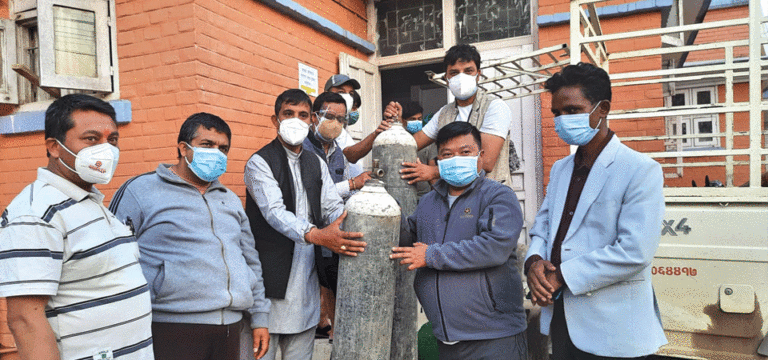
As the deadly second wave of COVID-19 pandemic began to engulf every corner of the country, local bodies across the nation have come forth to manage oxygen plants, isolation wards and quarantine centres. Shortage of oxygen has resulted in increased deaths across the country. The rural areas that were considered safer than the urban centres during the first wave of the pandemic last year are now witnessing a huge number of COVID-19 positive cases owing to the celebration of family functions and social activities without following strict health measures.
In response, many local bodies have established coronavirus treatment centres and managed oxygen plants. According to our Lumbini correspondent, a meeting of chiefs of local bodies and concerned organisations in Rupandehi organised by Butwal Sub-Metropolitan City has decided to establish a large oxygen plant in the district.
The meeting had deliberated over the installation and operation of the oxygen plant under the leadership of the local bodies.
A seven-member committee led by the Mayor of Butwal Shivaraj Subedi is formed for the same. Spokesperson of Butwal Ram Prasad Regmi said that another executive mechanism would be formed soon to steer the project further.
The meeting was attended by the chiefs of Sainamaina, Devdaha, Tilottama, Siyari, Marchawari and Suddhodan. Butwal will invest Rs. 10 million, other municipalities Rs. 5 million each and rural municipalities will mobilse Rs. 2 million each for the project.
Likewise, our Gorkha correspondent has reported that an oxygen plant is installed in the Gorkha Hospital. The hospital was planning to install the plant in its new building but for the time being it has decided to use if for the isolation beds, said Krishna Dhakal, Information Officer of the hospital.
Procured at Rs. 4.9 million, the plant can produce 80 litres of oxygen per minute. However, the produced oxygen can’t be filled in the cylinders. It goes to the isolation with HDU beds through the pipeline. The hospital has urged the Ministry of Health and Population to send the technicians to install the pipeline.
The hospital is operating 14 isolation beds and adding 18 more. Gorkha Municipality has allocated Rs. 4.5 million for the isolation beds in the hospital.
Nine local bodies in the district are running isolation in COVID hospitals but they don’t have oxygen supply. The district has only 100 cylinders. However, Gandaki Rural Municipality has 10-bed COVID hospital with oxygen facility. Chair of Gandaki Hom Bahadur Rana said that the hospital has a team of medical staff led by a doctor.
Kavre correspondent of The Rising Nepal has reported that the local bodies in the district are collecting swabs at ward-level. Panauti, Panchkhal and Mandan Deupur municipalities are leading the drive in running the mobile swab collection centres. All local bodies in the district are witnessing a surge in coronavirus infection.
Likewise, an oxygen plant is being established in Dolakha. Our Charikot reporter reported that District COVID-19 Crisis Management Centre and all nine local bodies have decided to establish the facility.
District Coordination Committee’s chief Dabal Pandey said that consultations had started to establish the plant either at Charikot Hospital or Jiri Hospital. The plant would have the capacity to fill at least 100 cylinders a day. Dolakha has also started PCR test in the district and working to convert the Singati Hospital as a COVID hospital.
District Police Office has collected 27 filled and 31 empty oxygen cylinders from hydroelectricity projects, vehicle workshops and crusher industries and handed them over to the Charikot Hospital.
Similarly, Hariharpurgadhi Rural Municipality of Sindhuli district has established a temporary COVID-19 hospital at its Conference Hall. Our correspondent from Sindhulimadi reported that the hospital was established at a cost of Rs. 650,000.
The local body has mobilised four health workers at the hospital and is trying to bring in an MBBS doctor, said Raju Uprety, Secretary of Ward No. 7 of Hariharpurgadhi.
Meanwhile, Chitwan Medical College’s Managing Director Dr. Harish Chandra Neupane has posted a status on Facebook that the hospital has run out of oxygen and is unable to take in new patients.
According to our Bharatpur correspondent, the hospital has its own oxygen plant with 500 litres per minute capacity but with the growing number of patients the hospital is buying about 400 oxygen cylinders daily.
Oxygen plants in the hospitals and a private sector company in the district produce about 880 cylinders in a day. Bharatpur Hospital produces 75 cylinders but consumes more than 200 cylinders.
Source : THE RISING NEPAL,






